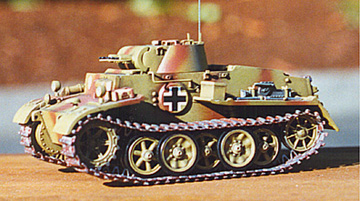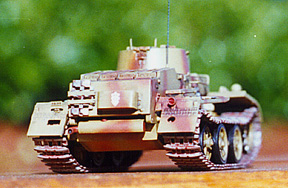
Model by Michael McSwiney
Panzerkampfwagen I Ausf. F
Model by Michael McSwiney

The Panzer I Ausf. F was more than a bit of an aberration in German tank design during World War II as it was a true Infantry tank in the British style. Whereas Blitzkrieg tactics demanded large formations of fast armor acting independently from the infantry, the infantry tank was heavily armored, slow, with generally light armament. It's primary function was to advance with the infantry providing fire support.
Model by Michael McSwiney

Development of the Panzer I Ausf. F was ordered in December of 1939 after the successful campaign in Poland. The design specification called for a Panzer I with the heaviest possible armor, with a prototype being finished by June 1940. An initial order for 30 of the vehicles was placed. A second order of an additional 100 vehicles was placed, but it was canceled before production began in April of 1942. It took until December of 1942 to complete the initial order of 30 machines.
Model by Michael McSwiney

The vehicle had numerous features very advanced for its day. Visibility for the commander was provided via five periscopes in the turret roof. The driver was provided with a vision slit much like the one used later on the Tiger I. Entry and exit from the hull of the vehicle was provided via two circular doors cut into the side of the hull. This position necessitated deletion of a fender for that section of the hull.
| Panzerkampfwagen I Ausf. F | |
|---|---|
| Crew: 2 | Armament: Two 7.92mm MG34s |
| Weight: 21.0 tons | Traverse: 360o (hand) |
| Length: >4.38 meters | Elevation: -10o to +20o |
| Width: 2.64 meters | Engine: Maybach HL234 |
| Height: 2.05 meters | Gearbox: 4 forward, 1 reverse |
| Radio: FuG5 | Speed: 25 km/hr |
Given only a few of these vehicles were produced, not a great deal is known about their service history. It is known that eight were issued to the 1st Panzer Division in early 1943. Some were also issued to 12thPanzer division as well. Three of the vehicles survived the war. One was captured by U.S. forces in German and taken to Aberdeen Proving Ground. This vehicle was unfortunately scrapped during the Korean war (like so many other historical vehicles). Two other Panzer I Ausf. F still survive in the former Eastern Bloc. One resides in an outdoor museum in Belgrade while the other is in the Russian Armor Museum at Kubinka.
Model by Michael McSwiney

Back to Panzerkampfwagen I Page